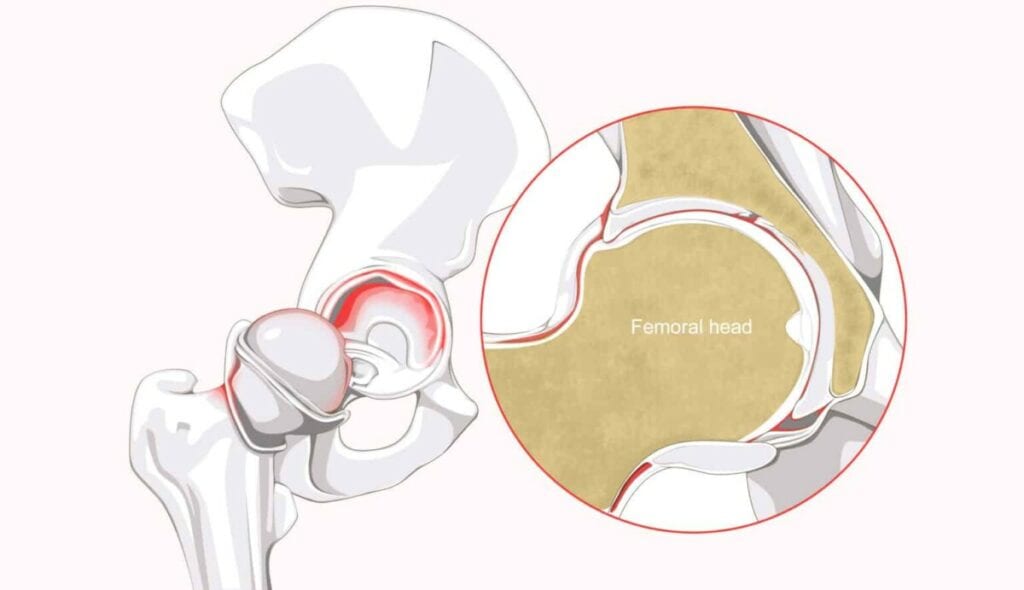Hip Labral Tear | Anatomy and Symptoms
- Best Asics Shoes for Flat Feet - October 25, 2024
- Best Running Shoes for Flat Feet - October 22, 2024
- Posterior Tibial Tendonitis - October 21, 2024
A hip labrum tear causes damage to the ring of cartilage that is part of the hip joint socket. This ring of cartilage is called the labrum and is attached to the rim of the socket to provide greater depth to the socket and, therefore, greater stability to the hip joint.
The hip labrum also ensures the retention of intraarticular fluid in the joint that provides lubrication, distributes load through the hip joint and helps with the absorption of impact (Bsat et al, 2016).
Symptoms
Hip lateral tears can be painful, but not always. Pain is usually felt at the front of the hip and into the groin area, with some cases reporting pain in the thigh, occasionally down to the knee, and less frequently into the buttocks.
Pain can sometimes be felt in the lower back, but less frequently. In addition to or without pain, sounds and sensations such as a click, pop, catch, stiffness, locking and giving way may be experienced. These symptoms are worse with walking, standing or sitting for long periods.
For anterior labral tears of the hip, pain may be worse with activities that flex the hip more, such as brisk or incline walking or running and sitting in low chairs. Often, pain is felt as a dull ache in the hip, but in more severe cases or very acute cases, pain can be very high and sharp, and the joint range of movement can become restricted.
Anterior and Posterior Labral Tear Hip
There are two areas where the labral tear is more likely to occur: anterior and posterior. Anterior or anterior superior tears of the hip are often felt at the front of the hip and into the groin and are the most common location. These tears are more common in individuals from Europe and the United States.
Posterior tears of the hip are less common, and usually, pain is felt deep in the hip or towards the back into the buttocks area. This location of tear is seen more in the Japanese population. Very few tears are found in a superior or lateral location. These differences can be attributed to differences in skeletal shape and where the hip is more vulnerable to wear and damage.
Causes
There are three leading causes of hip labral tears:
– Acute trauma: from sports to car accidents, if there is a high force through the hip joint, the labrum can be torn
– Structural shape of the hip: people have differently shaped hips (morphology), which can cause joint impingement and put more stress on the hip labrum. Examples are Cam (additional bone on the femoral head, or it may be less round) and Pincer (additional bone along the rim of the socket), which are very common morphologies, or hip dysplasia, which is often a shallow joint.
– High-intensity repetitive load: certain activities and sports have a higher risk of hip labral tear due to the speed of movements and positions they repeatedly do. Examples include ballet, dance, gymnastics, soccer, golf, hockey and rock climbing. These sports repeatedly load the hip joint in flexion, rotation, weight and/or high speed.

Diagnosis
Clinical Tests
A hip labral tear assessment should be thorough and done by an experienced physical therapist or sports doctor; there is no single, definitive test. There are a collection of signs, symptoms and tests, the results of which can provide a cluster and a sound basis for diagnosis. Diagnosis is only conclusive with diagnostic imaging, which you can read below.
Commonly used tests take the hip through a combination of movements to apply more pressure to areas of the labrum, such as the quadrant or scour test, FABER test (flexion abduction and external rotation) and FADIR (flexion, adduction and internal rotation).
These tests are positive if the individual’s pain symptoms are reproduced with or without a click or pop. These tests are not very sensitive or specific, so they should always be used with a detailed history and other clinical findings.
Other clinical findings that may indicate a tear include pain with actively raising the leg from a lying position, walking gait may present with a shorter step length on with the affected leg or maintaining a bent knee as these can both reduce impact and pain at the hip.

Imaging
MRI is the superior diagnostic tool for assessing a suspected hip labral tear. The images from an MRI are far more detailed concerning bone and joint health than an X-ray, and an MRI with contrast material can make it even more apparent to see for issues within the labrum structure.
If there is suspicion of a hip labral tear, it is ideal to confirm this with an MRI, but in many cases, due to the high expense of this diagnosis tool, it is not always an option. While an X-ray is not very sensitive to showing issues with the labrum, it will show the structural shape of the hip, which may indicate a risk for this injury.
Treatment can be started with a clinical assessment and diagnosis of a labral tear without imaging to confirm the diagnosis. If the individual is not experiencing improved pain and other symptoms as expected after 4-6 weeks, then an MRI becomes increasingly essential for clarification.
Hip Impingement vs Labral Tear
Differentiating between a suspected labral tear and other hip pathologies can be difficult. A hip labral tear can present similarly to hip impingement, and these two pathologies can occur together.
Hip flexor pain or snapping hip syndrome are other diagnoses that can present with similar pain and symptoms. An experienced clinician will be able to assess and test to determine which pathology is the likely diagnosis for your pain and symptoms and, therefore, direct with the best course of treatment.
_______________________________________
Related Articles:
Total Hip Replacement – Hip Bursitis – Hip Pain Running
We are specialists in Physiotherapy, with our clinic based in Fulham, South West London.
We offer Online Appointments for £60 and Face-to-Face appointments for £85 in our clinics.

